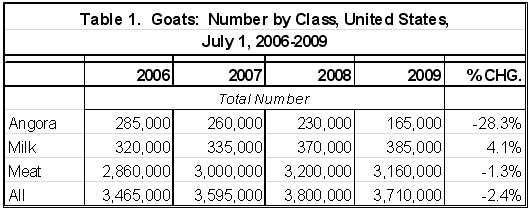Vol. 25, Issue 26, August 5, 2009 – PDF version
Jose G. Peña, Texas AgriLife Extension Economist-Management
USDA’s mid-year Sheep and Goats report, released on July 24, 2009, indicated that the U.S. sheep/lamb and goat inventory dropped about 3.0 and 2.4 percent respectively, from a year ago.
The U.S. sheep and lamb herd totaled 7.05 million head on July 1, 2009, down 220,000 head (3.0%) from an inventory of 7.27 million head on July 1, 2008, (See Figure 1). The size of the sheep and lamb herd is now the lowest since the mid-1940.
The U.S. all goat inventory, decreased by 90,000 head (2.4%) to 3.71 million head from an inventory of 3.8 million head a year ago (See Table 1). Please note that while the inventory of angora goats declined an additional 65,000 head (28.3%) to the lowest inventory since the early 1900’s, the size of the meat goat herd declined just slightly and remains above the size of the herd in mid-2007.
In 2006, the size of the sheep and lamb herd had increased for two years after eleven years of steady declines. It appeared that the size of the herd would stabilize at about 7.7-7.8 million head as the main commercial sheep product focused on lamb production and became less dependent on wool production. This shift appeared supported by a shift to more hair sheep. Now, the continuing severe drought which began in a large portion of Texas, especially southwest Texas, in early 2005 and intensified this year, a significant increase in predation control problems, high energy costs and the general softening of lamb and goat markets combined to influence individual decisions to continue to thin sheep and goat herds.
Lamb Market
Except for last fall’s dip, the lamb market has been showing improvement since mid-2002. Prices reaching record highs in 2005 as the total U.S. sheep and lamb inventory continued to decline. Feeder lamb prices at San Angelo weakened last fall but have remained relatively strong since spring 2008. While market prices remain attractive, improving this past spring, prices remain slightly lower than 2005’s record highs (See Figure 2). The market for feeder lambs is expected to continue to improve as feeder lamb supplies remain relatively tight.
Lamb Crop Down
The 2009 lamb crop is expected to total 3.7 million head down about 27,000 head (6.0%) from a lamb crop of 3.97 million head in 2008, with 88 percent of the lambs born prior to July 1, 2009. An additional 450,000 lambs are expected to be born during July through December 2009. Tight supplies of lambs, appears to indicate that the market will remain relatively strong. Keep in mind that while feeder lamb prices are slightly lower than 2005’s record highs, prices remain significantly above the 2000-04 average.
Breeding Herd Down
The breeding sheep and lamb’s inventory on July 1, 2009 at 4.28 million head was down 2.7 percent from July 1, 2008. (See Figure 1). The breeding herd consisted of 3.47 million ewes one year old and older, 180,000 rams one year old and older, and 630,000 replacement lambs (including newborn lambs). (See Table 2). The inventory of market sheep and lambs (including newborn lambs) at 2.77 million head, was down 3.5 percent from a year ago. The inventory of market lambs at 2.69 million head was down 3.8 percent from a year ago and consisted of 1.6 million lambs under 65 pounds, 560,000 lambs 65-84 pounds, 290,000 lambs 85-105 pounds and 240,000 lambs over 105 pounds. The market sheep inventory was 80,000 head.




